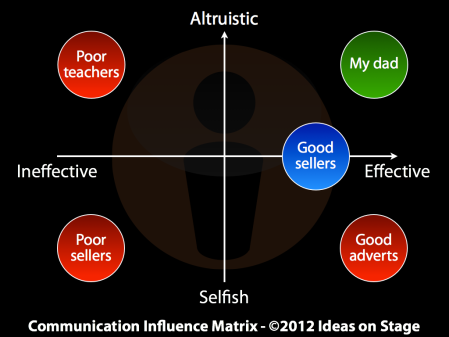
One of my executive students at HEC Paris asked me this week at what point communication becomes manipulation. After all, many of the rhetorical devices and storytelling techniques used in speechwriting and presentation design are similar to those used by a hypnotist, advertiser or salesperson.
This assumes there is a continuum, with communication at one end, and manipulation at the other end – and the more devices of influence you use, the more you move towards the ‘manipulation’ end of the scale.
An entrepreneur pitching an investor is aiming to influence that investor. Is that manipulation? The entrepreneur is doing everything possible to make an investor part with some cash, while at the beginning of the pitch the investor’s wallet is firmly closed.
A salesperson is always aiming to influence customers’ thoughts. Not only do they make you want their product or service where previously you perhaps didn’t want it (or didn’t realise you wanted it), but they also make you want their exact offering, and not those of your competitors. Is that manipulation? Or is it only manipulation if it is done well?
Let’s bring in a dictionary definition of manipulation. Dictionary.com defines ‘manipulate’ as:
to manage or influence skillfully, especially in an unfair manner: to manipulate people’s feelings.
My Chambers English Dictionary defines ‘manipulate’ as:
to turn to one’s own purpose or advantage
So the key factor is not the number of influence techniques used, but the intention of the speaker. Influencing the audience for your own selfish interests is considered manipulation, and has a negative connotation.
Advertising is all about manipulation, of course. Advertisers use every technique in the book to influence our thoughts, almost always for their own interests.
However, not everyone has selfish intentions. Take parents, for example.
Once, when I was a boy, I was flicking elastic bands around, and my father asked me to stop. He told me that once he had seen someone flick an elastic band which took someone’s eye out, i.e. it was very dangerous and I shouldn’t do it. The story was far stronger than just saying “stop doing that, son” – it certainly stopped me from flicking elastic bands, and I still remember the story over 30 years later. My father was using a storytelling technique to influence me – but for my benefit, so I would avoid a dangerous activity.
Now I am a father, and I use stories all the time to influence my children – for their benefit. This is far from new. Humans have been using stories for millennia to transfer knowledge and influence younger generations into avoiding the mistakes of their ancestors. The fable about the boy who cried ‘wolf’ is far more effective than just telling kids not to lie.
So while you can indeed have a continuum between ineffective and effective communication, there is another which is equally important: between altruism at one end of the scale – communicating purely for the audience’s benefit – and selfishness at the other end.
We can’t all be altruistic all the time. But we can at least aim for the middle of the scale: mutual interest.
Let’s take a look at what this means, in the Communication Influence Matrix above. In the bottom-left, you have ineffective and selfish communication – which is what poor salespeople dish out to long-suffering buyers. In the top-left, you have ineffective but altruistic communication, an example of which would be most teaching, which is for the benefit of the audience but far too often fails to be effective due to poor use of influencing techniques.
Then, in the bottom-right, you have effective and selfish communication – which could be good advertisements, or a powerful political speech for example. In the middle on the right, you have effective communication for mutual interest, which is what good salespeople will aim for. A good salesperson sincerely believes her customer will benefit from buying her product or service, and focuses on those benefits, while communicating effectively – and without forgetting her own company’s interests. Think of any Steve Jobs product launch.
And in the top-right, you have effective altruistic communication, and while I could have put public-service advertisements there, I’m proud to put my dad and his stories in that corner. One day, I hope my own children will put me there too.
Takeaways for presenters
As a presenter, work out how you can help your audience. If you are a salesperson, make your presentation not about your product or service, but about your customer’s problem and how it can be solved. You may succeed in making them want to buy your latest widget, but it will be in their interest to do so.
If you are an entrepreneur, talk about why your start-up offers a great opportunity for the investor. You’re not just going to them asking for money: you are offering them the chance to make a large pile of cash. You’re trying to influence them, of course, but in their interest as well as yours.
The trick is simply to ensure that their interests coincide with yours. If the customer is happy to solve their problem, that’s good for you because they’re using your widget to do so. If the investor is happy to invest because it’s a great opportunity, that’s also good for you because it means you have the cash to expand your company.
The audience’s own interest is the magical ingredient of any presentation. If you can always clearly act in the audience’s interest, you will never be accused of manipulation, no matter how many influence techniques you use. And if you can find a way to meet their needs while also meeting yours, then everybody wins.

Phil,
The way you set up the chart does your analysis a disservice. As you point out later in the article, “what’s good for the listener” and “what’s good for presenter” are actually independent axes, and so “mutual interest” isn’t well represented here.
If somebody is attempting to persuade somebody else, you can effectively tick the “good for presenter” box. You are left with a chart with two axes: effective/ineffective and good/bad for listener.
Assuming the vertical axis is bad for listener at the bottom, good for listener at the top, “Manipulation” would be represented as the lower right quadrant, and “Mutual interest” would be top right.
Thankfully, due in large part to social media, any form of persuasion that “lies” — i.e. attempts to portray something as a listener benefit, but isn’t — will get found out very fast. Social media is increasing transparency, driving out the bad, and encouraging the good.
So I believe the real answer to your student’s question is that communication is a weapon that people can try to use for good or bad, but that manipulation is increasingly difficult…
Other nits:
* I think it’s too cynical to say that politics is about manipulation. I think they do have strong convictions, and for better or worse, most of them would have more money/power if they stuck to the private sector (but they’re still human, so will and do make mistakes…)
* Entrepreneur/Investor. The investor is actually dying to open her wallet — to the right investment (e.g. Facebook turning people away). It just happens there are fewer people with money to invest than are good entrepreneurs with good ideas.
Well, the first rule of presenting is that you can’t please everyone all the time! But thanks Timo for taking the time to comment and share your thoughts.
I take your points about the matrix, although personally I don’t see a problem with an axis which has an intended benefit for A at one end, an intended benefit for B at the other end, and an intended benefit for both in the middle. I’d be interested to hear what others think about this.
I don’t agree that you can always tick the ‘good for presenter’ box. I spent some time yesterday trying to persuade someone about something, and it means absolutely nothing to me whether she takes it on board or not – I was simply acting for what I perceived as her benefit. True ‘naked presenters’ are always acting for their audience’s benefit, without regard to their own.
And I also don’t agree that manipulation is always bad for the audience as your matrix would suggest. Sure, you manipulate someone if you are aiming to get them to do something for your benefit and not theirs. But the fact it’s intended to benefit you doesn’t mean it’s bad for them. If Lacoste advertises its clothes to me, that’s entirely intended for Lacoste’s benefit and not mine, but buying their clothes is not bad for me. I wouldn’t want my matrix to have advertising for clothes in a different place to advertising for fast food, just because some may judge that buying one of them is bad for the audience. Whether it’s good for the audience is not relevant there: it’s about the communicator’s intention, not the end result of the desired action.
Fully agree though that nowadays any insincere communication can be found out extremely quickly, so you should never lie, and it’s always best to appear not to have selfish intentions. But you can tell the truth in manipulative ways. And call me cynical if you will: I accept that, because I see politicians using manipulation all the time, and while there are a few good eggs in there, most appear to crave power (not money) rather than public service. My father did a term as a local councillor, but got fed up of being stifled by selfish career politicians who were in it for themselves and not their constituents, and I know local councillors in my village who feel much the same.
And investors – well, yes they are always open to great ideas, but the default position at the start of a pitch is that their chequebook isn’t (yet) open, and they need to be persuaded to open it.
Love to hear some other points of view on the matrix debate!
Phil
Hi,
personally I made my conviction that all communication is a manipulation, since it does influence others.
The red line between “manipulation” (with a negative meaning in the common language and communication, perceived as positive in the common language, is the integrity of the speaker and the speech.
“Communicating is manipulating with integrity”
“Manipulating is communicating without integrity”
, which join most of the points you mention in your post.
Bruno
[…] 45 seconds. And yet, there is much to be learned from the presentation perspective.Phil Waknell considers the line between communication and manipulation.The audience’s own interest is the magical […]
Social science research suggests that we can influence peoples’ attitudes, beliefs and behaviors by helping them UNDERSTAND ideas and circumstances. We can use stories, thematic messages, and information to get them to THINK, dig more deeply in their own minds for why they believe what they believe. When we are effective, they question their own beliefs through internal conversations and conversations with others. A compelling message may stimulate them over time to change their beliefs and behaviors. We are more powerful communicators when we introduce messages that lead them into that deeper thought, which all works with their specific values and beliefs.
I like the article and agree that persuasion of some sort is usually the intent of communication. Provocative messages (themes) that encourage us to think are more likely to persuade us to change behavior. Lots of research these days underpin the ways that communication are used to encourage desirable behaviors in healthcare, environmental stewardship and sustainable management of communities and organizations.
It’s an interesting discussion.